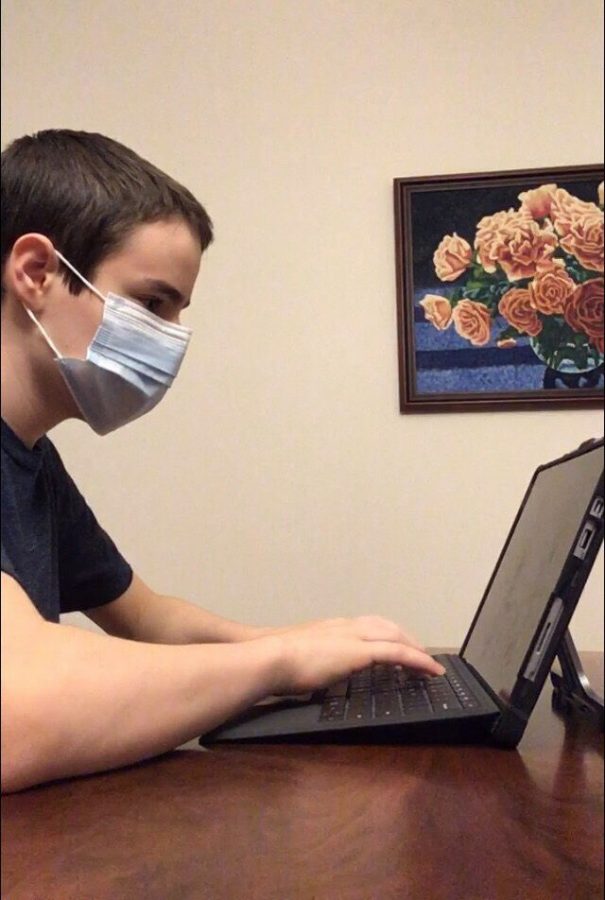Student discusses private high school’s precautions amid pandemic
Published September 24, 2020
All St. Louis public high schools will be operating completely virtually until they reassess in October. Private schools however, have the choice to open up or not, and many have opened.
There are certain policies required by Missouri and St. Louis County, such as wearing masks, while others are recommended by the Centers for Disease Control, like taking temperature checks, enforcing social distance and cleaning thoroughly. Beyond this, many schools have implemented their own rules.
“In every classroom they’ve measured 10 feet between each table. Because we have, on average, eight kids in a class, it’s pretty easy to separate and socially distance,” Whitfield sophomore Stephen Rosenberg said.
A big dilemma when creating a plan for schools is adhering to social distancing guidelines whenever possible. Whereas public schools usually have less space per person, private schools have the resources necessary to create more physical space for their students.
“Though it’s one building, they’ve completely closed the doors in certain parts of the building so that it acts as two separate buildings,” Rosenberg said. “Certain grades stay with other certain grades, like middle school, in their own ‘building,’ freshmen are in their own ‘building,’ sophomores and juniors are together and seniors are virtual right now.”
Regardless of how much classroom space and how many teachers per student a school has, crowding may occur.
“They’ve staggered the ending times of each class, so the halls are less crowded. Occasionally, you might have to wait in your next class for five minutes before you can leave so that hall traffic can be cleared,” Rosenberg said.
Another place where crowding could be an issue is the restrooms.
“In between each class, a teacher who teaches in a classroom near the bathroom will stand outside the bathrooms because kids aren’t allowed to go to the bathroom during passing period,” Rosenberg said.
Surely, one of the most difficult scenarios to arrange was lunch. Normally, students would stand in a dense line to get their school lunch. In the days of the coronavirus however, distance is key once again.
“When you’re waiting to get your lunch, you have to wait in a socially distanced line, which isn’t that hard because usually there are like five kids at a time there,” Rosenberg said.
Once students have their lunches, seating is another issue. Just last year, no one batted an eye if students sat within feet of each other in the cafeteria; now, that’s unthinkable.
“There’s an option to sit outside or inside, but they require you to wear your mask the whole time until you sit down to actually eat. [For seating] we have some long tables and they have one chair for each head of the table, so that way, when you eat, you’re far from everyone else,” Rosenberg said.
This strict management could lead to some awkward social situations, but Rosenberg and his friends have a system so that they can still eat lunch together.
“[My friends and I] usually get two tables that are next to each other. So that I can sit 12 feet from the person across from me and six feet from the person next to me,” Rosenberg said. “I don’t feel like doing the math now, but you could figure out the diagonal.”
On top of all the social distancing precautions, Whitfield has also instituted shorter school days and a week off every third week to minimize the possibility of an outbreak. Students also get free periods that allow them to arrive at school late, leave early or get homework done at the building.
“One of the days I have [my free period] last period so I can leave school early. The other day I have it in the middle of the day so I just do whatever homework I have,” Rosenberg said.
All in all, a return to school required intricate planning to keep everyone safe while still maintaining high level academics. Even so, there are still some oddities that have to be figured out as the school year continues.
“I’m at the part of the school with all the science classes so some of my classes are in rooms meant for science,” Rosenberg said. “So there are some science teachers that have to teach without a lab and then my math and English teacher have a lab.”
As more issues are resolved, other issues are sure to arise as time passes.
“I had to sneeze once so I asked the teacher if I could go to the bathroom and I sneezed in the bathroom,” Rosenberg said.
In spite of all the safety precautions, COVID-19 doesn’t seem to care about how much planning is put into an operation to keep it running smoothly. It is still extremely dangerous.
“If a teacher or student from a different section of the building [got COVID] I would feel fine about going back to school since they’re basically completely separate buildings. If someone in my building got it though, I would be hesitant to return” Rosenberg said.














